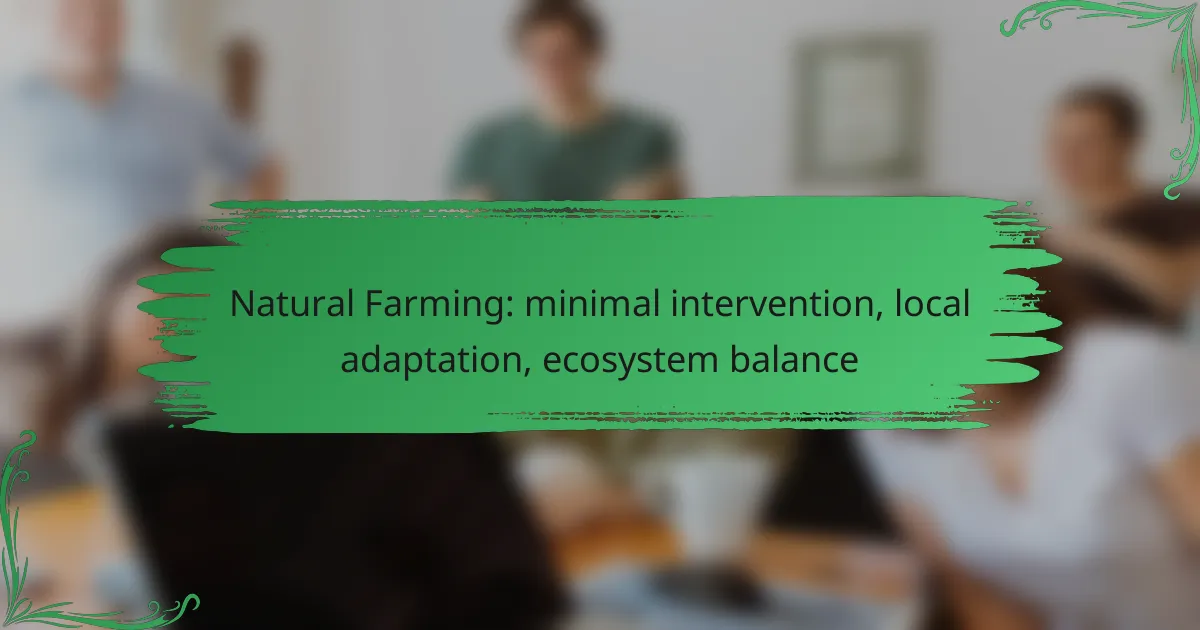Companion planting is a gardening technique that involves pairing plants to enhance growth, deter pests, and improve overall yield. Understanding plant compatibility is essential for creating a thriving garden ecosystem, as it can lead to healthier plants and increased productivity. By strategically selecting companions, gardeners can navigate the uncertainties of yield while fostering a more resilient environment.

What are the benefits of companion planting in urban gardens?
Companion planting in urban gardens offers various advantages, including improved pest management, enhanced pollination, and increased biodiversity. By strategically pairing plants, gardeners can create a more resilient ecosystem that supports healthy growth and yields.
Improved pest control
Companion planting can significantly reduce pest problems by utilizing natural deterrents. For example, planting marigolds alongside vegetables can repel nematodes and aphids, minimizing the need for chemical pesticides.
To maximize pest control, consider planting herbs like basil near tomatoes, as they can confuse pests and attract beneficial insects. Regularly monitor plant health and adjust pairings based on observed pest activity.
Enhanced pollination
Companion planting can boost pollination rates by attracting a variety of pollinators. Flowers such as borage or lavender can draw bees and butterflies, which are essential for fruit and vegetable production.
To enhance pollination, plant flowering species in close proximity to crops that require pollination. Ensure a diverse range of flowering plants is available throughout the growing season to support pollinator populations.
Increased biodiversity
Incorporating companion planting in urban gardens promotes biodiversity, which is vital for ecosystem health. A diverse plant community can improve soil quality, reduce disease spread, and create habitats for beneficial organisms.
To foster biodiversity, mix various plant types, including herbs, flowers, and vegetables. This approach not only supports wildlife but also enhances the overall resilience of the garden against pests and diseases.

Which plants are compatible for companion planting?
Companion planting involves pairing plants that benefit each other, enhancing growth, deterring pests, or improving flavor. Understanding which plants are compatible is crucial for maximizing garden yield and health.
Tomatoes and basil
Tomatoes and basil are a classic companion pairing. Basil can enhance the flavor of tomatoes and may help repel pests like aphids and whiteflies. When planting, ensure basil is spaced adequately to allow airflow around the tomato plants, which can help prevent fungal diseases.
For optimal growth, plant basil close to tomatoes, ideally within a foot. This proximity allows for mutual benefits while ensuring that both plants receive sufficient sunlight and nutrients.
Carrots and onions
Carrots and onions are compatible due to their differing root structures, which allows them to share space without competing for nutrients. Onions can deter carrot flies, while carrots can help mask the scent of onions, reducing pest attraction.
When planting, consider alternating rows of carrots and onions to maximize space and benefits. Maintain a distance of about 15-20 cm between each plant to ensure they have enough room to grow without hindering each other.
Beans and corn
Beans and corn form a beneficial relationship known as the “Three Sisters” when combined with squash. Beans fix nitrogen in the soil, which corn can utilize, while corn provides support for climbing bean plants. This synergy promotes healthy growth and efficient use of garden space.
Plant corn first, allowing it to establish before adding beans. Space corn plants about 30 cm apart, and plant beans at the base of each corn stalk to ensure they have adequate support as they grow. Avoid overcrowding to prevent competition for light and nutrients.

How does companion planting affect crop yield?
Companion planting can significantly improve crop yield by enhancing plant health and maximizing space. By strategically pairing compatible plants, gardeners can create beneficial relationships that lead to increased productivity and reduced pest issues.
Potential yield increase
Companion planting often results in a notable yield increase, sometimes ranging from 10% to 50%. For example, planting basil alongside tomatoes can enhance flavor and growth, while marigolds can deter pests that harm vegetable crops. These synergistic effects can lead to more robust harvests.
Additionally, certain combinations can optimize nutrient uptake. For instance, legumes like beans can fix nitrogen in the soil, benefiting neighboring plants that require this nutrient, thus promoting overall yield growth.
Yield variability factors
Yield variability in companion planting can arise from several factors, including plant compatibility, soil health, and environmental conditions. Not all plant combinations yield the same benefits; some may compete for resources rather than support each other. Understanding which plants work well together is crucial for maximizing yield.
Weather conditions, such as temperature and rainfall, can also impact the effectiveness of companion planting. For example, a dry season may hinder the growth of certain plants, leading to lower yields despite the companion planting strategy. Regular monitoring and adjustments based on local climate can help mitigate these risks.

What are the prerequisites for successful companion planting?
Successful companion planting requires an understanding of plant compatibility, soil quality, and climate conditions. These factors significantly influence plant growth and yield, making them essential for gardeners aiming to maximize their harvest.
Soil quality assessment
Assessing soil quality is crucial for effective companion planting. Healthy soil should have balanced pH levels, adequate nutrients, and good drainage. Conducting a soil test can help identify deficiencies and inform amendments, such as adding organic matter or fertilizers.
When selecting companion plants, consider their nutrient needs. For instance, legumes can enrich the soil by fixing nitrogen, benefiting neighboring plants. Conversely, heavy feeders like tomatoes may require more nutrients, so pairing them with nutrient-rich companions can enhance growth.
Climate considerations
Climate plays a vital role in companion planting success. Different plants thrive in specific temperature ranges and moisture levels, so understanding your local climate is essential. For example, warm-season crops like peppers and basil flourish in hotter conditions, while cool-season plants like lettuce and peas prefer milder temperatures.
Additionally, consider the growing season length in your area. In regions with shorter growing seasons, choose fast-maturing companion plants to ensure they can grow and benefit each other before the first frost. Always check local planting calendars to optimize your planting schedule.

How to create a companion planting plan?
Creating a companion planting plan involves selecting compatible plants that benefit each other and arranging them effectively in your garden. This strategy enhances growth, reduces pests, and optimizes space, leading to a more productive garden.
Identify plant pairs
Start by researching which plants thrive together. For example, tomatoes and basil are known to enhance each other’s growth, while carrots and onions can deter pests. Utilize resources like gardening books or online databases to find compatible plant pairs based on their growth habits and nutrient needs.
Consider the specific benefits of each pairing, such as pest control, improved pollination, or nutrient sharing. Keep in mind that some plants may also inhibit the growth of others, so avoid combinations like beans and onions.
Map garden layout
Once you have identified compatible plant pairs, sketch a layout of your garden. Place taller plants, such as sunflowers, on the north side to avoid shading shorter plants like lettuce. This arrangement maximizes sunlight exposure and encourages healthy growth.
Use a grid system or raised beds to organize your plants efficiently. Make sure to leave adequate space between pairs to allow for air circulation and easy access for maintenance. A well-planned layout can significantly enhance your garden’s productivity.
Schedule planting times
Timing is crucial in companion planting. Some plants thrive in cool weather, while others prefer warmth. For instance, plant cool-season crops like peas and lettuce in early spring, and warm-season crops like peppers and tomatoes after the last frost.
Consult a planting calendar specific to your region to determine the best times for sowing seeds or transplanting seedlings. Staggering planting times can also help ensure a continuous harvest throughout the growing season.

What are common mistakes in companion planting?
Common mistakes in companion planting include overlooking the specific needs of plants and overcrowding them, which can lead to reduced yields and unhealthy growth. Understanding plant compatibility and spacing is crucial for successful gardening.
Ignoring plant needs
Ignoring the specific needs of plants is a frequent error in companion planting. Each plant has unique requirements for sunlight, water, and nutrients, and failing to consider these can hinder growth. For example, pairing sun-loving tomatoes with shade-preferring lettuce can stunt the growth of both.
To avoid this mistake, research the needs of each plant species before planting. Group plants with similar requirements together to ensure they thrive. A simple checklist of light, water, and soil preferences can help maintain compatibility.
Overcrowding plants
Overcrowding plants is another common mistake that can lead to competition for resources. When plants are too close together, they may struggle for light, water, and nutrients, resulting in poor yields. For instance, densely packed beans may not produce as well as those spaced appropriately.
To prevent overcrowding, adhere to recommended spacing guidelines for each plant type. A general rule is to leave enough space for mature plants to grow without shading or competing with one another. Using a planting grid can help visualize spacing and ensure optimal growth conditions.

How does companion planting vary by region?
Companion planting practices can differ significantly based on regional factors such as climate, soil type, and local pests. Understanding these variations helps gardeners optimize plant pairings for better growth and yield.
Regional climate impacts
The climate of a region plays a crucial role in determining which plants can thrive together. For instance, warmer regions may support heat-tolerant species like tomatoes and basil, while cooler areas might favor combinations like peas and lettuce. Gardeners should consider their local climate zones when selecting companion plants.
Additionally, rainfall patterns can affect plant compatibility. In regions with high humidity, certain plants may be more susceptible to fungal diseases, making it essential to choose companions that promote airflow and reduce moisture retention. For example, planting marigolds with vegetables can deter pests while allowing for better air circulation.
Soil types also vary by region, influencing nutrient availability and root compatibility. Sandy soils may require different companion strategies compared to clay soils. Conducting a soil test can help gardeners understand their soil’s characteristics and select appropriate companion plants that enhance soil health and yield.



